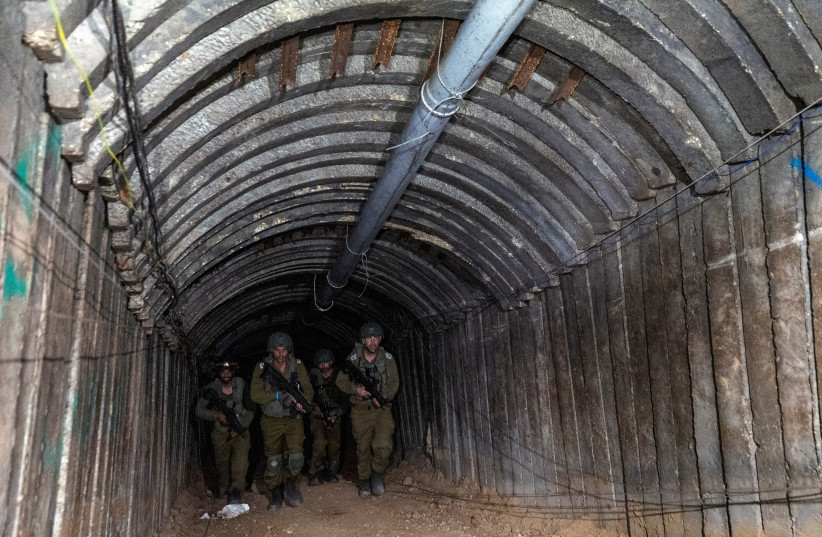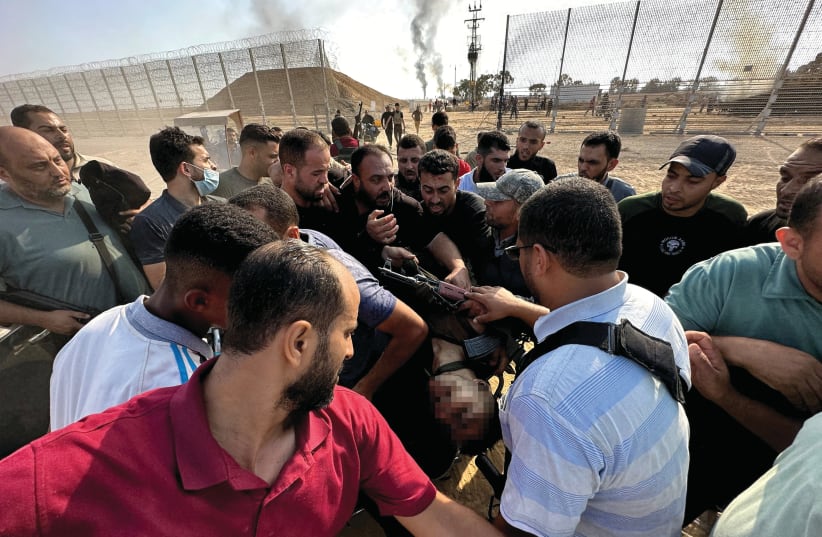CNN International diplomatic editor Nic Robertson descended to the depths of a Hamas combat tunnel under Khan Yunis this week, revealing the intricate infrastructure that makes it so difficult for the IDF to rescue hostages, assassinate the terrorist group’s leaders, and end the war.
In doing so, Robertson impressively illustrated to his viewers why the war has not been completed, despite stretching on for more than 100 days. His report’s visuals revealed the answer better than 1,000 words.
Robertson could not have gone into the tunnel – or safely into Gaza at all – were it not for him being brought by the IDF.
The network rightfully added a disclaimer that accompanied the report when it aired on TV and posted it on its website and social media platforms.
“CNN reported from Gaza under Israel Defense Forces escort at all times,” the disclaimer said. “As a condition for journalists to join the embed with the IDF, media outlets must submit footage filmed in Gaza to the Israeli military for security review. CNN did not submit its final report to the IDF and retained editorial control.”


But CNN, which aims to be balanced and has arguably succeeded at that goal during this war, provides no disclaimer for its regular reports out of Gaza. Perhaps the network and other media outlets should enable their viewers and readers to understand that reports from Gaza are not like reports filed from a democracy that strives to guarantee freedom of the press.
“CNN reported from Gaza, which is under the control of the Hamas terror group,” such a disclaimer could say. “As a condition for journalists to work from here, we report what they want us to report if we want to stay alive. Our editorial control is questionable.”
News consumers tend to be unaware of Israel’s decision to forbid reporters from entering Gaza unaccompanied, intended to prevent harm to journalists. The IDF has facilitated the entry of as many embedded journalists as possible, but the last Gaza war where Israel permitted journalists to enter the Gaza Strip on their own was Operation Protective Edge in 2014, when they went in through the Erez Crossing, which Hamas destroyed on October 7.
The impact of the decision has been that while the top journalists in the world parachuted into Israel and reported whatever they wanted with almost no limits, in Gaza media outlets have relied throughout the war on Gazan freelancers and ordinary Gazans with cellphone cameras.
Who are the freelance reporters in Gaza?
Who are these freelancers? It has unfortunately become evident during this war that among the world’s top media outlets, the standards for hiring freelance writers, photographers, and cameramen are considerably lower in Gaza than in Greece or Guatemala.
The media watchdog HonestReporting revealed on November 8 that Gazan freelance journalist Hassan Eslaiah, who worked for both CNN and the Associated Press on October 7, crossed into Israel and took photos of a burning Israeli tank and infiltrators entering Kibbutz Kfar Aza. Eslaiah was found to be close with Hamas leader Yahya Sinwar, the mastermind of the massacre.
While CNN and AP both broke ties with Eslaiah after the reports, AP continues to employ freelancer Issam Adwan, who HonestReporting revealed had called publicly for the annihilation of Israel and a “Palestinian revolt” and compared Israel to the Nazis. Adwan has not had a byline since that October 11 report, but he remains with AP.
On January 7, media widely reported that Israel had killed two Palestinian “journalists” in Gaza – Al Jazeera freelancers Hamza Al-Dahdouh and Mustafa Thuraya, who had also been an AFP contributor. The reports quoted Al Jazeera’s condemnation of the deliberate Israeli “targeting” of journalists.
But barely any media outlets bothered to update or correct their report three days later when the IDF released evidence proving that Al-Dahdouh and Thuraya had been terror operatives.
Last week, HonestReporting published an investigation of Mohammed Fayq Abu Mostafa, a freelancer working for Reuters. In a video revealed by the probe, Abu Mostafa called on Gazans to cross the border into Israel on Oct. 7, as he did, and he excitedly displayed live on Instagram footage he filmed of Hamas atrocities, including the lynching of an Israeli soldier.
Abu Mostafa bragged that he had been in Israel “since the beginning” and detailed what he saw both at the border and deep inside Israel, in Sderot. He described breaking into a room where Israelis were hiding before being kidnapped by Hamas terrorists.
His border photos, including one of the lynching, were recently selected by Reuters and The New York Times to be included in their 2023 “Images of the Year.” On Monday, Reuters led its compilation of photos from 100 days of war with a snapshot of Gazan infiltrations taken by Abu Mostafa.
The same investigation highlighted a friend of Eslaiah and Abu Mostafa, photojournalist Ashraf Amra, who has been working for AP, Reuters, and APA Images, as well as for the Turkish agency Anadolu. The investigation found that Amra had been honored with kisses by Hamas leader Ismail Haniyeh, who visited him in an Istanbul hospital in September.
Haniyeh told Amra during the visit that he appreciated his role and that of the Palestinian media in exposing “the crimes of the occupation.” Amra replied that his injury, which he blamed on Israel, would not prevent him from returning to his “national role.”
The high-profile hospital visit was not the first time Haniyeh had honored the veteran photojournalist, to whom he presented an award in 2012.
Such revelations cast doubt on the journalistic impartiality of such freelancers and the vetting procedures of media outlets that have relied on their work.
A commitment to journalistic ethics and basic humanity should prompt the news organizations to answer fundamental questions:
- What exactly are their vetting procedures for freelancers in Gaza?
- And, if there are different codes of conduct for freelancers vs. permanent staff in Gaza or elsewhere, then why isn’t that disclosed in every article that a freelancer works on?
There needs to be much greater transparency on the vetting process if men like Abu Mostafa and Amra, who mocked 1,200 Jews being murdered, are being treated like professionals by mainstream news organizations.
The media outlets clearly do not care about improving their standards if firings and suspensions only occur when they get caught.
The writer is executive director and executive editor of HonestReporting. He served as chief political correspondent and analyst of The Jerusalem Post for 24 years.
